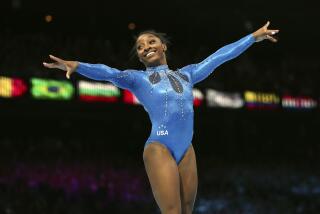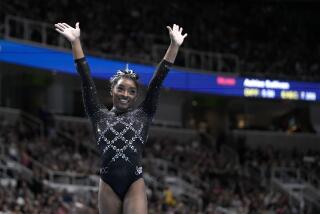The High Schools / John Lynch : Perils of Gymnastics Obvious to Adamek
- Share via
Watching them prance around barefoot and clad in white tights, gymnasts rank low on the macho meter, but after serious examination of the sport, it is difficult to challenge their courage.
Danger and injury are part and parcel of the day-to-day life of a dedicated practitioner, which accounts for much of the sport’s appeal, according to Shawn Adamek, one of the top gymnasts in City Section history.
“When you master a skill by overcoming the danger and putting your fears behind you, you feel like a man,” the 18-year-old Monroe senior said. “It takes a long time to get used to the danger. You try not think about it but you can’t help being scared. You’ve got to be an idiot not to realize how dangerous the sport is.”
Even those at the opposite end of the intelligence spectrum, however, fall prey to the sport’s dangers. Adamek (5-foot-11, 140 pounds) carries a 3.5 grade-point average, is editor of the school newspaper and will attend Stanford next fall on a gymnastics scholarship. But academic achievement buys little insurance against bad luck.
Adamek suffered a broken bone in his left forearm during a routine warm-up drill before a match against University on March 30. While limbering up on the high bar, his left hand became entangled and locked up while he swung around the bar. He attributed the injury to a new pair of leather hand grips but said that the accident could have happened to anybody.
“You can always lock up on the high bar. It’s just part of the sport,” he said.
Still, it led to a gruesome afternoon for Adamek. He hung for nearly a minute with his arm wrapped around the bar and it took seven teammates to get him down.
“I don’t exactly remember how many times I went over but I could feel that my hand wasn’t moving,” he said. “Some people say you go into shock but I never did. I felt the whole thing.”
Adamek was taken to the hospital where the worst part of the ordeal ensued. After the bone broke in half, the pieces overlapped each other because the surrounding muscles had cramped and contracted. Traction in the form of a small weight attached to his arm was prescribed in order to separate the bones.
“That was probably the worst pain,” he said. “For about 15 to 20 minutes I sat there. They didn’t give me any drugs. It was torturous.”
Two days later, he underwent surgery that left two metal plates and 10 screws in his arm. He missed two weeks of school and had the cast removed this week. The pain has long since subsided, but he was reminded of the anguish when the new City Section champion, Frank Baca of Huntington Park, was crowned this week.
As a junior, Adamek led Monroe to the school’s 10th City title and swept all seven events in the individual championship, a feat accomplished only by Monroe’s David Moriel, who won an NCAA title at UCLA in 1987. Not only was Adamek sidelined for Thursday’s meet at University, he did not attend. Because of his injury, he is unable to drive.
He faces a lengthy rehabilitation process and it seems likely that he will miss this summer’s junior national competition in Wisconsin. Perhaps the lone bright spot for Adamek is his own history. He has learned the hard way that he is a fast healer.
His gymnastics career started when he was 7, and, by the time he was 12, he ranked among the top five in the country in the his age group. But as a seventh-grader, he underwent surgery to repair a torn rotator cuff in his left shoulder. He returned to competition after an 18-month absence and placed a disappointing 60th in the junior nationals in the 15- to 18-year-old division.
“I was losing to guys I used to beat regularly and that was pretty hard to take,” he said.
A year later as a sophomore at Monroe, he competed in just one full meet. First, he broke the top plate of his right foot during a floor-exercise routine. Then, he broke his left foot in his first meet after the right foot had healed.
Adamek’s attitude after each injury has remained consistent: He wants to get back on the pommel horse.
“I replay the injury all the time and try to make myself remember,” he said. “If I don’t think about it, it could become my worst fear. I want to get back to the gym, even if it’s just to breathe the chalk.”
Les Sasvary, who has coached at Monroe since 1963, calls Adamek his most talented gymnast. He has seen his protege compete since he was 7 and is a close friend of the Adamek family. Both he and Adamek’s father Joseph escaped from Hungary during the 1956 anti-government uprising that was eventually quashed by the Soviet Union.
“This is very, very sad for Shawn,” Sasvary said. “He’s intelligent, tremendously motivated and is lean and very flexible. Within a short time he will emerge as one of the top collegiate gymnasts. One day he may be in the Olympics.”
Adamek says that he dreams of Olympic gold, but other goals are more immediate. After a wasted senior season, he wants to start anew in college.
“There’s a lot of luck involved with the Olympics,” he said. “If you reach your height in the wrong year, you’re out of luck. I feel like I’m just starting my career now. I haven’t been in the thick of the nationals yet. This feels like the start of the big time.”
More to Read
Get our high school sports newsletter
Prep Rally is devoted to the SoCal high school sports experience, bringing you scores, stories and a behind-the-scenes look at what makes prep sports so popular.
You may occasionally receive promotional content from the Los Angeles Times.






